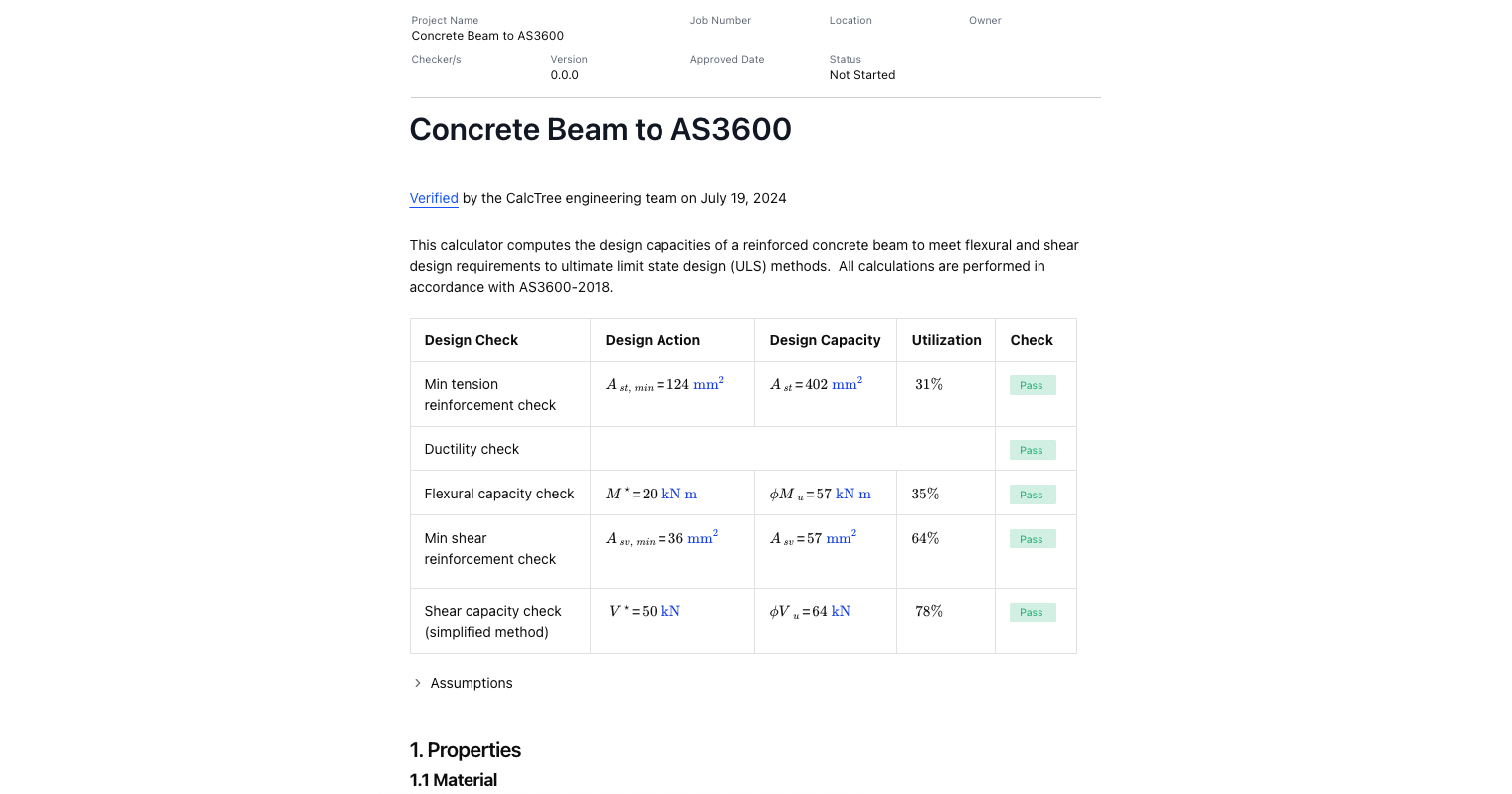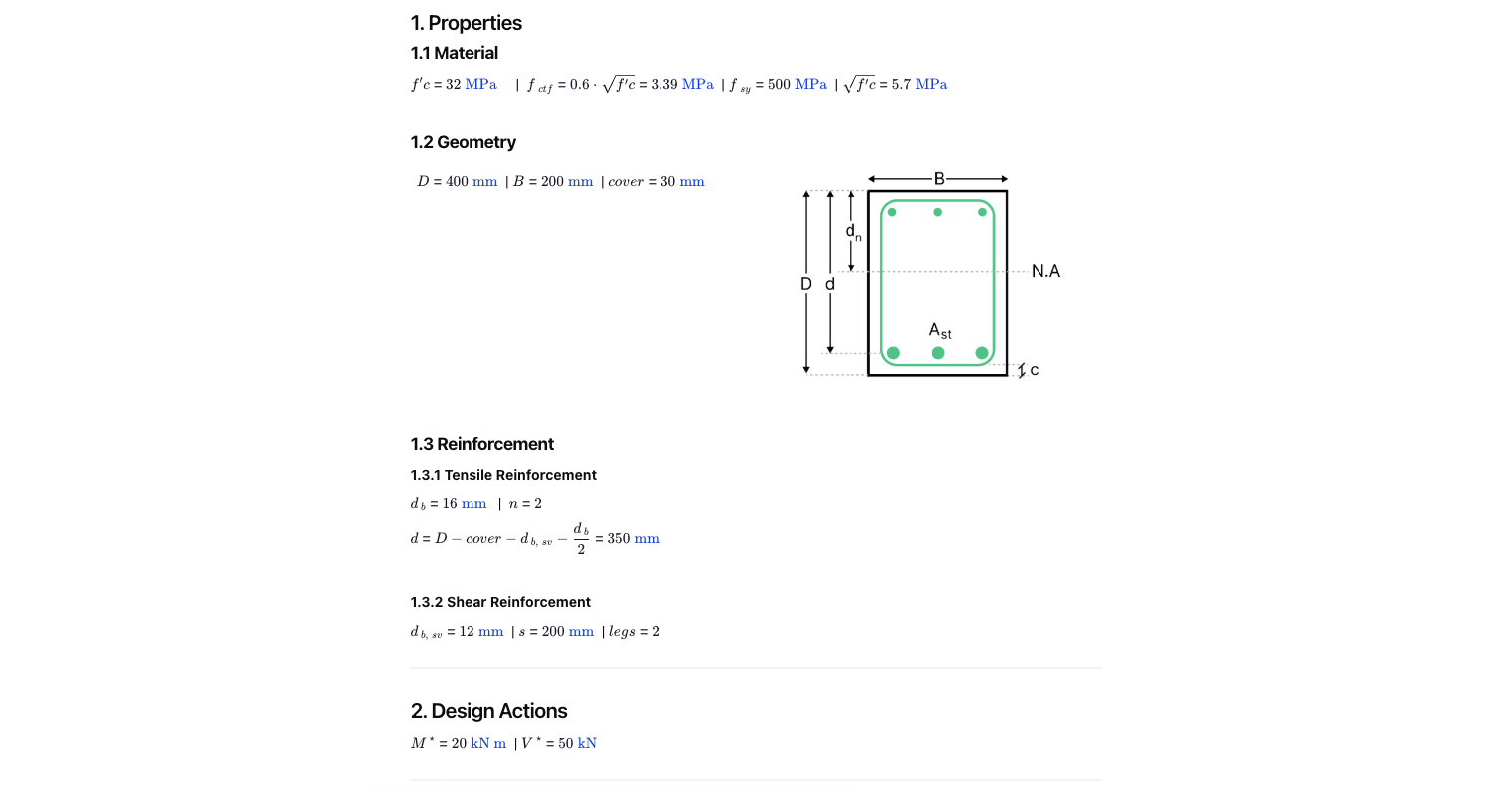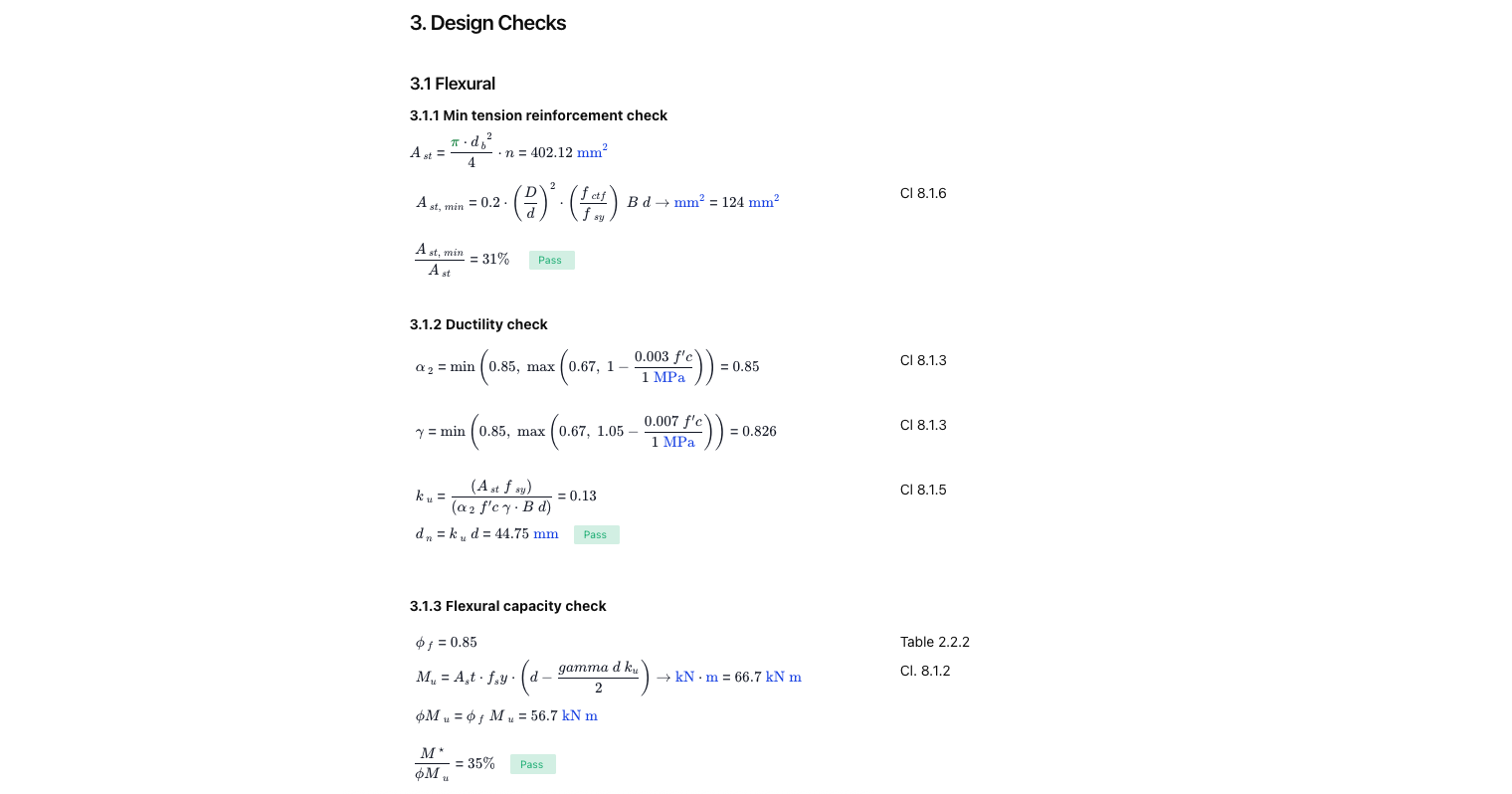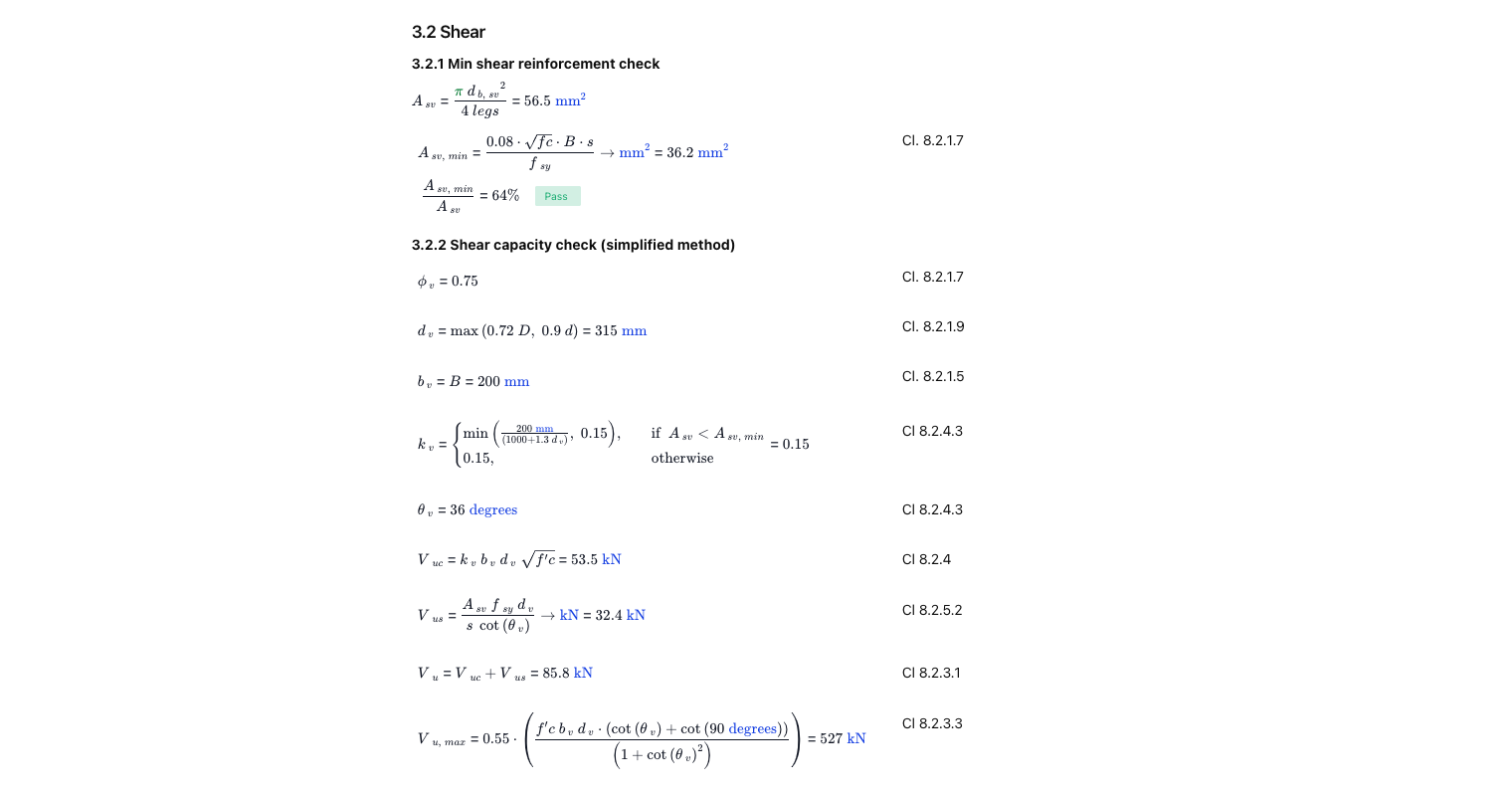Free Concrete Beam Design Tool to AS 3600. Step-by-step, engineering-grade tool with downloadable report.

This template is not available yet. You can sign up and create it yourself!
Or let us know if you'd like to be notified when it’s ready:
About this Concrete Beam Design to AS 3600 Calculator
The Concrete Beam Design to AS 3600 calculator computes the design capacities of a reinforced concrete beam to meet flexural and shear design requirements to ultimate limit state design (ULS) methods.
This calculator is built for structural engineers, civil engineers, and designers who work with reinforced concrete beams in residential, commercial, and infrastructure projects.
It simplifies the process of checking bending capacity and shear reinforcement against AS3600:2018 requirements. By using the tool, engineers can reduce manual calculations and focus on decisions that matter.
For a comprehensive design guide to accompany this design tool, please see: Concrete Beam Design: Australian Standards AS3600
General Info on Concrete Beam Design Calculations
Stress Blocks and Flexural Design
AS 3600 uses a rectangular stress block (sometimes referred to as an equivalent rectangular stress block) to model the compression zone in a concrete beam when it’s under bending. This simplification allows engineers to determine the neutral axis depth and the resulting bending moment capacity. The assumption is that the extreme compressive fibre of the concrete crushes at ultimate strength while the tensile steel yields.
Shear Reinforcement and Minimum Requirements
Shear is resisted partly by the concrete shear strength and partly by shear reinforcement (stirrups). AS 3600 prescribes a minimum shear reinforcement amount even when calculated shear forces are low, ensuring ductility and crack control. Correct stirrup spacing and shear reinforcement area must be provided for safety and constructability.
Simplified Method for Beam Design
For standard cases, AS 3600 allows a simplified method for beam design—particularly for typical spans with normal weight concrete and uniform dead load and vertical loads. This method streamlines the calculation of bending capacity and reinforcement selection, especially for a rectangular reinforced concrete beam.
Longitudinal Reinforcement and Serviceability
The longitudinal reinforcement handles tension forces from flexure. Engineers must check tensile stresses, deflection limits, and minimum steel requirements to avoid long-term serviceability issues. This includes ensuring correct concrete cover for durability and fire protection.
Want to learn more before starting on this template? See: Concrete Beam Design: Australian Standards AS3600
Common Calculation Errors to Avoid
- Ignoring the neutral axis location: Misjudging the neutral axis depth can lead to unsafe assumptions about when the concrete crushes or the steel yields, skewing bending moment checks.
- Underestimating shear: Some engineers rely solely on concrete shear strength, forgetting the mandatory minimum shear reinforcement in AS 3600, even when calculated shear is low.
- Incorrect stirrup spacing: Overly wide stirrup spacing reduces ductility and can violate the code’s minimums.
- Mixing lightweight concrete assumptions: Using lightweight concrete without adjusting the strength reduction factor or capacity reduction factor can invalidate the design.
- Neglecting the bending moment diagram and shear force diagram: Skipping these diagrams risks missing peak demand points for flexural and shear reinforcement.
- Not checking reinforcement ratio: An inadequate or excessive reinforcement ratio affects ductility and may breach reinforced concrete design rules.
All of these considerations are covered in the template that's available to use for free today.
Engineering templates
Common calculators
Design guides
FAQs
What are the main changes to AS3600:2018 compared to the previous edition AS3600:2009?
There has been significant updates and changes since the 2009 edition, mainly concerning:
- Rectangular stress-block configuration (Section 8.1.3)
- Values of the capacity reduction factor Φ, for different action effects (Table 2.2.2)
- Shear and torsion design (Section 8.2)
What is the role of the rectangular stress-block in concrete beam design to AS3600:2018?
The flexural (also referred to as 'bending' or 'moment') capacity of a beam cross-section is determined using the Rectangular Stress Block method (Section 8.1.2). The compressive stress distribution in concrete under bending is curved in reality, however it can be converted to an equivalent rectangular stress block by the use of reduction factors α2 and γ.
Do all reinforced concrete beams require shear reinforcement?
Yes. AS 3600 mandates minimum shear reinforcement for most reinforced concrete beams to prevent sudden brittle failure, even if shear demand is low.
How do you design a concrete beam against shear to AS3600:2018?
The total shear capacity of a section is the combination of the shear strength contributed by concrete and shear reinforcement. AS3600 (similar to other international codes) use a truss analogy of shear resistance, where the diagonal concrete strut is in compression and the vertical tie (provided by shear reinforcement) is in tension. The strut angle θv affects the distribution of shear resistance:
- a smaller θv means the strut crosses more shear ligs and therefore a smaller area of shear ligs is needed
- a larger θv means more of the applied shear force is taken by the vertical tie (shear ligs) and therefore a larger area of shear ligs is needed
The code limits θv ≥ 36° to ensure the required shear reinforcement is not under-conservative.
Summary and References
This calculator helps engineers confidently design reinforced concrete beams, avoid common mistakes, and ensure compliance with Australian standards.
For deeper guidance, refer to:
- Concrete Beam Design: Australian Standards AS3600
- AS 3600:2018 Concrete Structures Standard
Learn about the benefits of using CalcTree on engineering projects!











